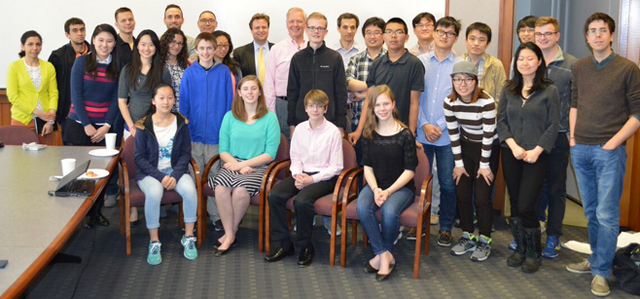Students Investigate Mechanical Properties of Spider Web
It isn't often that 8th graders inspire scientists with their class project. When a group of scientists at the Massachusetts Institute of Technology found that a spider's web from the basement had an unusual pattern, they invited a small team of middle school students to investigate its mechanical properties. Their work caught the attention of the MIT researchers and also landed a talk at M&M 2016.
With the poster at M&M 2016: 8th grader Nicholas Moy, teacher Douglas Shattuck, and Vern Robertson of JEOL.
Doug Shattuck, an 8th grade Concord Middle School teacher, has successfully dovetailed his classroom projects with his summer work at MIT in the Civil and Environmental Engineering department (headed by Prof. Markus Buehler, Ph.D.) where the focus is development of novel composite materials. He has also had a long-time affiliation with JEOL USA, specifically Vern Robertson, who has on occasion imaged samples of balsa wood and 3D printed models of synthetic materials for the Laboratory for Atomistic and Molecular Mechanics using a SEM at JEOL's Peabody, Mass. headquarters. During a previous school year, when balsa wood properties were being investigated in the Lab, Shattuck had his students design balsa wood bridges capable of bearing a hundred times their own weight. This was in conjunction with the atomistic modeling of how the wood fails at the atomic bonding level.
More recently, the lab had done 3D printing of spider webs to study mechanical strength and reported their findings in 2015 publications. After observing the weaving process and reviewing the micrographs, Dr. Zhao Qin, a Research Scientist, found that the structural features of the sheet web produced by an Araneidae spider were too difficult to be duplicated with synthetic materials in the similar manner as spiders. The web construction proved even more interesting because of the unusual complexities that the SEM images revealed are connected to how the spider constructs the web, a tedious work performed in an elegant way.
SEM images show the unique pattern in the junctions between the rays of this particular spider's web and the chords that helically wrap each ray.
The researchers were surprised to see an "odd crossover that hadn't been seen before" - a unique pattern in the junctions between the rays of this particular spider's web and the chords that helically wrap each ray. With the goal of determining if the helically wrapped chords (shown in frames 2,3, and 4) provided any mechanical advantage when it comes to managing normal tensile forces acting on the web, the students utilized the SEM images and evaluated ways of reconstructing an analog of the web design using sewing thread and trying different designs for a 3D printed loom with which to make them. The results of their findings were originally slated for a poster at M&M as part of the Microscopy Outreach program which promotes microscopy in education as an important learning tool for inspiring future STEM professionals. When it was learned that the research had shown some unusual properties of the spider web, the poster was elevated to a platform talk.

Concord Middle School students formed a good relationship with MIT researchers during their work. Standing in the middle are MIT Prof. Markus Buehler, Ph.D., and Concord Middle School 8th grade teacher Douglas Shattuck.
The talk was given by 8th grader Nicholas Moy, whose parents were pleased to be able to make the trip to Columbus, Ohio for the opportunity. Shattuck accompanied him and was able to see not only how well his students were able to thoroughly investigate the challenge they were given, but also experience the other side of being a scientist, writing and presenting a paper.
This research per se helps to reveal the secret of web architecture by providing the relation between the complex web structure and its advanced mechanical function. It will also shed light on the design of strong and light synthetic composite materials with their reinforced fibers arranged in the similar way as the spider web. Shattuck's students receive a certificate for their work, and have had the unique experience of being part of a real-world science lab and following real procedures to solve scientific problems. It's an experience that surely will give them a leg up in the future should they decide to pursue science in their careers.
Complex Web Construction: A Possible Clue to Mechanical Properties